KolibriOS: Interview with Sergey Kuzmin (Wildwest)
Meet the corporate user blog KolibriOS . On behalf of this user, articles written by freelancers in the framework of the KolibriOS Blog Looking for Authors will be published, as well as project participants who do not have a user on Habré or who don’t want to publish articles on their own for any reason.
As the first publication, we offer you an interview with Sergey Kuzmin (Wildwest nickname), one of the “old-timers” in the KolibriOS project (on Habré W__W ).
1. Tell about yourself who you are and where are you from? What do you do?
')
I teach in one of the universities of St. Petersburg - I conduct laboratory and practical workshops, I read lectures. In science, I am engaged in algorithms for automatic analysis of video information for computer vision systems and applied television. He wrote more than 40 articles, last year he co-authored the monograph. From the opening of Coursera (spring 2012) I have been following the courses on technology and IT: some I just download in the hope of sometime to see, and I study others - I received certificates from three professors in computer vision - Jitendra Malik, Guillermo Sapiro, Irfan Essa.
2. How long have you been on this project?
I found out about it ( MenuetOS - editor's note ) from the print version of the article www.comprice.ru/articles/detail.php?ID=43137 in the second half of July 2003.
A few weeks later I went online, went to menuet.narod.ru , downloaded various distributions. First I decided to launch the German distribution Gerschi ( menuet.narod.ru/arch2003_3.htm ). He looked very colorful.

When after a while I launched the official distribution, I was unpleasantly surprised - it looked less well-groomed. Then I did not have a stable Internet access, so I could only go to the project sites once every few weeks. In 2004, with the onset of summer, I began to participate in discussions in the Russian-speaking forum, and in the autumn in discussions in English-speaking forums. Then I started doing CPUID and other things that are described below.
3. What do you do in the project KolibriOS?
In the MenuetOS and KolibriOS projects, I was engaged in those programs that were not completed at that time, as well as in journalistic, advertising, and human rights activities. I'll tell you in order:
In MenuetOS there was a program for displaying the frequency of the processor. I decided to develop it and gradually appeared CPUID - a program showing the characteristics of the processor. Initially, the program interface was constantly changing, but then stabilized.
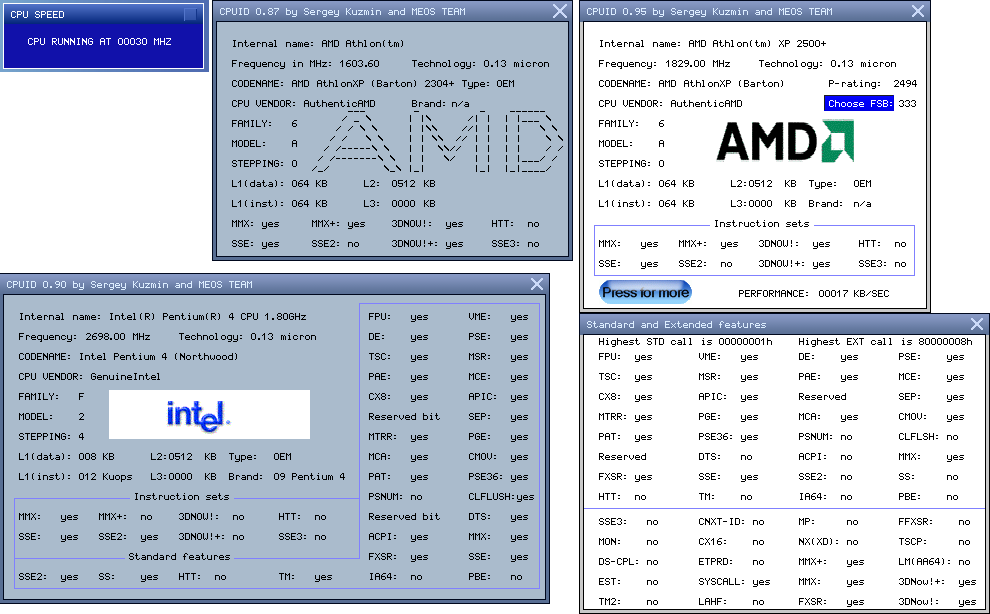
During the development, an inaccuracy was found in the OS kernel , and I was on the MenuetOS developer list. Then the program also entered the distribution kit ( CPUID - editor's note ). In 2006-2007, it was already a very solid program, comparable to CPU-Z . Apparently, it was the first program for MenuetOS / KolibriOS, in which the program interface changed depending on the detected iron. For Intel processors, there was a usual interface, and for AMD additional elements appeared - a button for selecting the bus frequency (the system bus frequency detection was not done yet) and an inscription with a calculated performance rating (top right in the figure). It should be noted that many people helped test this program and wrote code for it, helped with the design (@Heavyiron, Leency , Mario_Z , Ghost_nsk , halyavin , grechnik ). An interesting technique was connected with the beautiful button for calling the second window - an image was drawn over the button, and if the user clicks on the image, you will click on the button. Outwardly, it looked like a skin button, but in fact it was two different components.
Then there was PCIDEV - a project started by an American. He simply output a lot of numbers without decryption and the class of the device. I started decoding numbers into a clear description - the names of the companies, the detailed purpose of the device. Other developers are involved in this process. Now it is one of the most useful programs.
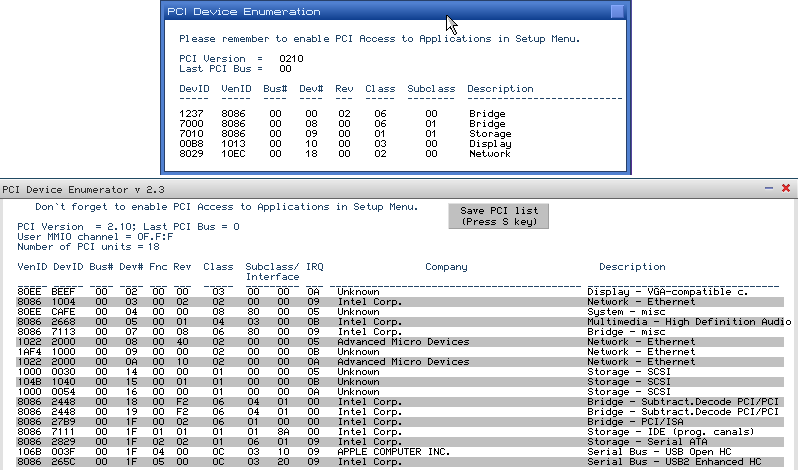
The next modified program is Tetris , written by Italian. For him, I paused, because during the game I often had to be distracted, and did not want to lose points. I made a pause quickly, so I looked through the arisen cheat: during the pause, you can rotate the shape and move it left and right. Whoever fixes the cheat will be great (you need to put checks to be in the game mode or pause in the keyboard processing cycle).

There was also an unfinished project SuperMP3 - preparation for the music player mp3 files. Other developers also took part in it, but in the end everything stopped, because there was still poor support for sound cards.
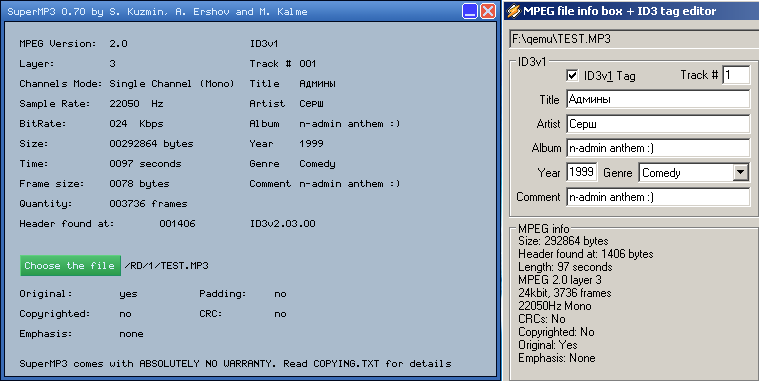
My journalistic work began with the fact that I led the news of alternative operating systems on my website, and they paid much attention to KolibriOS. I also commented on this news, so the news page was in some way a blog. I interviewed the project leaders: I talked a little with Finn Ville Turyanmaa (founder of MenuetOS), Englishman Mike Hibbet , Pole Yaroslav Pelcar , Belarusian Mikhail Semenyako (aka mike.dld ) and Marat Zakiyanov (aka Mario79, aka Mario_Z , aka Mario_r Marat then asked to remove the interview with him from my site. He paid a lot of attention to translations of various articles and the history of Menuet / KolibriOS ( the largest article ).
As part of the advertising OS published two articles in print ( www.comprice.ru/articles/detail.php?ID=42992 , samag.ru/archive/article/1742 ) and another one in electronic . When the OS was released, many of our team went to computer forums and websites to write about it.
(A small lyrical digression hidden under the spoiler - editor's note)
In May 2006, I began to work on my video analysis program, I actively wrote articles on computer vision. Gradually, the time at Kolibri remained less and less. As a result, in the fall of 2007, I stopped developing for it, but from time to time I continued to visit the project forum and wiki. Recently, I was asked to add support for modern processors to the CPUID program. I will also try to rummage around on the hard drives: apparently, many programs are simply forgotten, and among them is a screensaver with geometric figures - a masterpiece of the demoscene.

4. What attracts you to him? Why?
When I saw it, I felt a great contrast with the Linux distributions of that time. It was placed on several CDs, required a hard disk repartition, the programs depended on a lot of libraries ... MenuetOS was compact and unpretentious in this regard. Then I really liked the community. I tried many Axes, participated in some communities (the Russian keyboard layout in Syllable appeared at my request) and I can say that, compared with them, the MenuetOS / KolibriOS commands were much more active, international and responsive.
Many articles, FAQs were published, contests for the creation of logos and programs were held, then they began to produce electronic journals . Programming for this OS was initially not very attractive, but the macros and libraries of widgets gradually appeared. They speed up application development several times. The API is still evolving - support for working with USB devices has recently appeared . Several KolibriOS API emulators have been developed for running programs on other operating systems. It is relatively easy to change any part of the operating system.
5. What future do you see in this OS?
The concept of the OS was originally a problem - Ville made a conceptual OS, and, after proving the concept, the need for some further development actions was apparently not so obvious to him. Therefore, he happily became involved in the 64-bit version - a new goal appeared. But in the end, too, nothing much happened, including because of the closed source code. In this regard, collective development is often more productive, because Everyone’s goals are slightly different and a universal product is obtained. On the other hand, the number of distributions and forks specialized for industrial use is growing. This, in general, is also a positive process, if the bugs found in these distributions are described in the project forum and corrected in the main distribution. There is no point in talking about the competition of the distros at this stage, although it would certainly have spurred the development of the operating system.
We have a problem with the project leader in recent years. After leaving diamond 'a ( grechnik ), no distribution came out. There are only regularly updated nightly builds . But it seems to me that he will be released in the coming months, because Soon there will be 1 million lines ( not counting the C libraries, because of which the total number of lines is incorrectly displayed - editor's note ), and the Kolibri Summer Of Code ends.
The community is constantly growing, especially after the creation of a group in social networks ( for English-speaking users, a group was created on Facebook - editor's note ). There are first-class programmers in the project - our two developers ( hidnplayr , Mario79 ) constantly appear in the top of "Recently Active Contributors" on Ohloh . This same link shows that there are quite a lot of assembly language projects, and one can hope for new people to come.
Regarding the industrial purpose of the OS - I will mention five examples (the rest are described on our forum ):
(In the photo below - use at the factory for SCADA-system)

The question of embedding KolibriOS in the BIOS has been discussed for quite a long time, which will give certain opportunities to both programmers and users. ( Although even there is already one working example - editor's note. )
Thus, with hands and knowledge, KolibriOS can be adapted for any task.
At last - atmospheric pictures of fans: mine and South American.
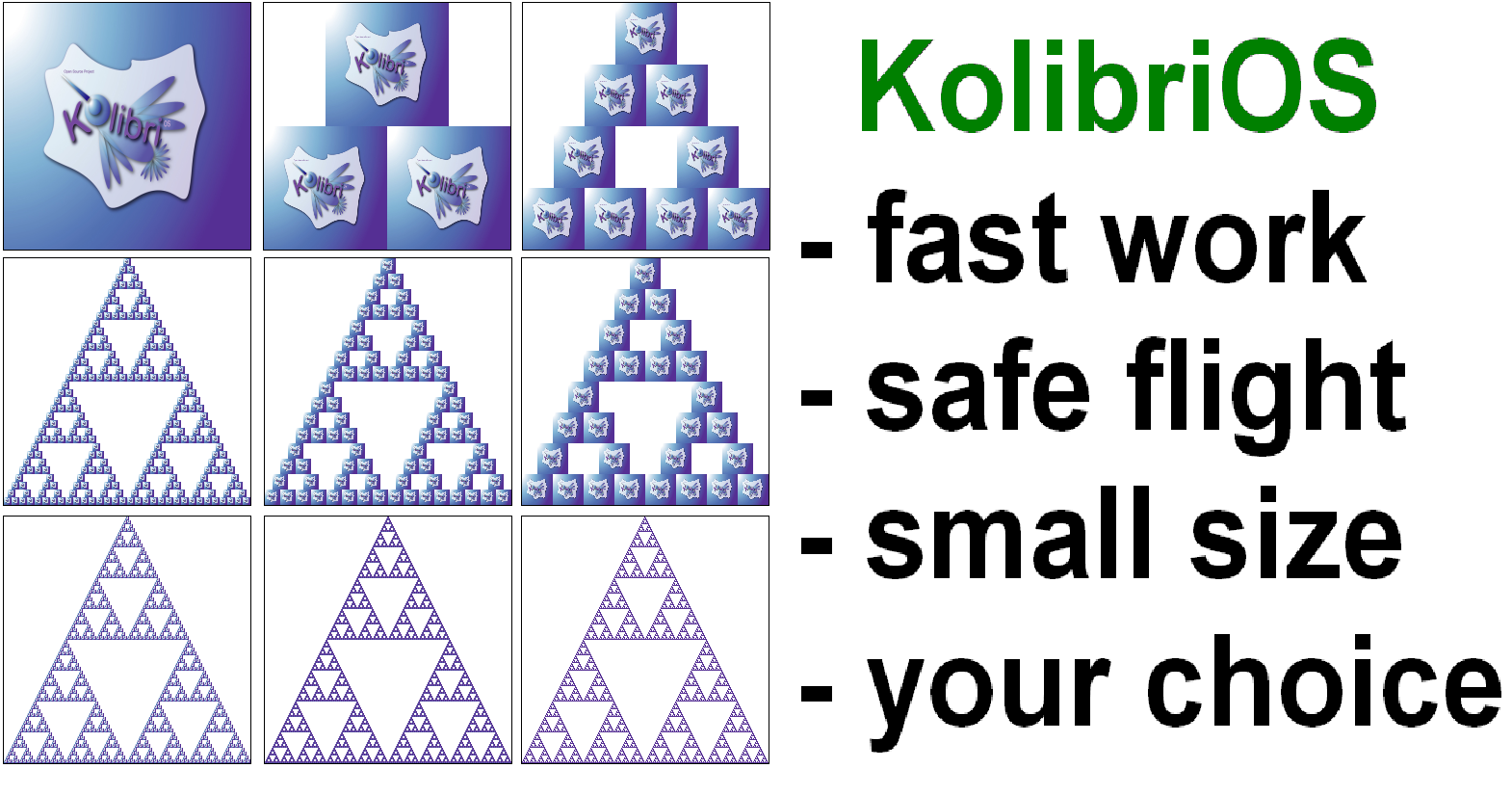

As the first publication, we offer you an interview with Sergey Kuzmin (Wildwest nickname), one of the “old-timers” in the KolibriOS project (on Habré W__W ).
1. Tell about yourself who you are and where are you from? What do you do?
')
I teach in one of the universities of St. Petersburg - I conduct laboratory and practical workshops, I read lectures. In science, I am engaged in algorithms for automatic analysis of video information for computer vision systems and applied television. He wrote more than 40 articles, last year he co-authored the monograph. From the opening of Coursera (spring 2012) I have been following the courses on technology and IT: some I just download in the hope of sometime to see, and I study others - I received certificates from three professors in computer vision - Jitendra Malik, Guillermo Sapiro, Irfan Essa.
2. How long have you been on this project?
I found out about it ( MenuetOS - editor's note ) from the print version of the article www.comprice.ru/articles/detail.php?ID=43137 in the second half of July 2003.
A few weeks later I went online, went to menuet.narod.ru , downloaded various distributions. First I decided to launch the German distribution Gerschi ( menuet.narod.ru/arch2003_3.htm ). He looked very colorful.

When after a while I launched the official distribution, I was unpleasantly surprised - it looked less well-groomed. Then I did not have a stable Internet access, so I could only go to the project sites once every few weeks. In 2004, with the onset of summer, I began to participate in discussions in the Russian-speaking forum, and in the autumn in discussions in English-speaking forums. Then I started doing CPUID and other things that are described below.
3. What do you do in the project KolibriOS?
In the MenuetOS and KolibriOS projects, I was engaged in those programs that were not completed at that time, as well as in journalistic, advertising, and human rights activities. I'll tell you in order:
In MenuetOS there was a program for displaying the frequency of the processor. I decided to develop it and gradually appeared CPUID - a program showing the characteristics of the processor. Initially, the program interface was constantly changing, but then stabilized.

During the development, an inaccuracy was found in the OS kernel , and I was on the MenuetOS developer list. Then the program also entered the distribution kit ( CPUID - editor's note ). In 2006-2007, it was already a very solid program, comparable to CPU-Z . Apparently, it was the first program for MenuetOS / KolibriOS, in which the program interface changed depending on the detected iron. For Intel processors, there was a usual interface, and for AMD additional elements appeared - a button for selecting the bus frequency (the system bus frequency detection was not done yet) and an inscription with a calculated performance rating (top right in the figure). It should be noted that many people helped test this program and wrote code for it, helped with the design (@Heavyiron, Leency , Mario_Z , Ghost_nsk , halyavin , grechnik ). An interesting technique was connected with the beautiful button for calling the second window - an image was drawn over the button, and if the user clicks on the image, you will click on the button. Outwardly, it looked like a skin button, but in fact it was two different components.
Then there was PCIDEV - a project started by an American. He simply output a lot of numbers without decryption and the class of the device. I started decoding numbers into a clear description - the names of the companies, the detailed purpose of the device. Other developers are involved in this process. Now it is one of the most useful programs.

The next modified program is Tetris , written by Italian. For him, I paused, because during the game I often had to be distracted, and did not want to lose points. I made a pause quickly, so I looked through the arisen cheat: during the pause, you can rotate the shape and move it left and right. Whoever fixes the cheat will be great (you need to put checks to be in the game mode or pause in the keyboard processing cycle).

There was also an unfinished project SuperMP3 - preparation for the music player mp3 files. Other developers also took part in it, but in the end everything stopped, because there was still poor support for sound cards.

My journalistic work began with the fact that I led the news of alternative operating systems on my website, and they paid much attention to KolibriOS. I also commented on this news, so the news page was in some way a blog. I interviewed the project leaders: I talked a little with Finn Ville Turyanmaa (founder of MenuetOS), Englishman Mike Hibbet , Pole Yaroslav Pelcar , Belarusian Mikhail Semenyako (aka mike.dld ) and Marat Zakiyanov (aka Mario79, aka Mario_Z , aka Mario_r Marat then asked to remove the interview with him from my site. He paid a lot of attention to translations of various articles and the history of Menuet / KolibriOS ( the largest article ).
As part of the advertising OS published two articles in print ( www.comprice.ru/articles/detail.php?ID=42992 , samag.ru/archive/article/1742 ) and another one in electronic . When the OS was released, many of our team went to computer forums and websites to write about it.
(A small lyrical digression hidden under the spoiler - editor's note)
A brief history of the separation of KolibriOS from MenuetOS
In the summer of 2004, Ville was preparing to move to Paris, and appointed Hibbet as project manager . After some time Hibbet disappeared, and there was a need to change the project manager. It should be noted that in 2003-2005, new fixes, drivers and programs were regularly posted on our forum, while at the official forum most of the developments concerned the interface, translation and other OS modding. Some of our developments were announced on the official forum and the FASM compiler forum , but did not get into the distribution, because Distributions themselves were collected quite rarely and, apparently, from what was sent to the project managers by mail.
In this difficult time, I, along with other members of our team (Sniper, Mario79 ), tried to convey to Ville and the English-speaking community the idea that most of the real MenuetOS developers are in the countries of the former USSR, and we need to appoint someone who knows English well and Russian languages. In general, he defended the rights of "Soviet" developers. Our team saw in this role mike.dld , who had a good relationship with Ville, and he was also in our team. It was never possible to do this: Pelcar was appointed as the head , then by voting at the official forum many supported his candidacy. Then Pelcar left, and the project was left without a leader at all.
Ville himself was not interested in the situation with Menuet32 at that moment, because He worked on Menuet64 and regularly uploaded new screenshots . The absence of a manager and regular official releases gave a new impetus to the development of distributions, one of which was Kolibri . (There were also other Russian-language distros, of which Menuet RE was considered the main one for a long time, but then its developer Ivan Poddubny disappeared.)
When, after a while, Ville reappeared and said that the 32-bit branch closes, and everyone needs to write programs for Menuet64, then most of the developers did not support it. Our team argued with the forum for several days, and then simply declared its independence and renamed the distribution kit Kolibri into the operating system KolibriOS . Ville didn’t like it, and then he wrote many times that we stole his code, and also deleted topics about KolibriOS in the forums he controls. As a result, MenetOS mentions were added to the boot screen , and copyrights were added to the kernel files . ( CleverMouse was removed from the boot screen in revision # 3759 on July 4, 2013, almost 10 years after it was added, because, according to her, “ less than 20% of Minuet’s functionality remains in the Hummingbird ” - approx. editor.)
In this difficult time, I, along with other members of our team (Sniper, Mario79 ), tried to convey to Ville and the English-speaking community the idea that most of the real MenuetOS developers are in the countries of the former USSR, and we need to appoint someone who knows English well and Russian languages. In general, he defended the rights of "Soviet" developers. Our team saw in this role mike.dld , who had a good relationship with Ville, and he was also in our team. It was never possible to do this: Pelcar was appointed as the head , then by voting at the official forum many supported his candidacy. Then Pelcar left, and the project was left without a leader at all.
Ville himself was not interested in the situation with Menuet32 at that moment, because He worked on Menuet64 and regularly uploaded new screenshots . The absence of a manager and regular official releases gave a new impetus to the development of distributions, one of which was Kolibri . (There were also other Russian-language distros, of which Menuet RE was considered the main one for a long time, but then its developer Ivan Poddubny disappeared.)
When, after a while, Ville reappeared and said that the 32-bit branch closes, and everyone needs to write programs for Menuet64, then most of the developers did not support it. Our team argued with the forum for several days, and then simply declared its independence and renamed the distribution kit Kolibri into the operating system KolibriOS . Ville didn’t like it, and then he wrote many times that we stole his code, and also deleted topics about KolibriOS in the forums he controls. As a result, MenetOS mentions were added to the boot screen , and copyrights were added to the kernel files . ( CleverMouse was removed from the boot screen in revision # 3759 on July 4, 2013, almost 10 years after it was added, because, according to her, “ less than 20% of Minuet’s functionality remains in the Hummingbird ” - approx. editor.)
In May 2006, I began to work on my video analysis program, I actively wrote articles on computer vision. Gradually, the time at Kolibri remained less and less. As a result, in the fall of 2007, I stopped developing for it, but from time to time I continued to visit the project forum and wiki. Recently, I was asked to add support for modern processors to the CPUID program. I will also try to rummage around on the hard drives: apparently, many programs are simply forgotten, and among them is a screensaver with geometric figures - a masterpiece of the demoscene.

4. What attracts you to him? Why?
When I saw it, I felt a great contrast with the Linux distributions of that time. It was placed on several CDs, required a hard disk repartition, the programs depended on a lot of libraries ... MenuetOS was compact and unpretentious in this regard. Then I really liked the community. I tried many Axes, participated in some communities (the Russian keyboard layout in Syllable appeared at my request) and I can say that, compared with them, the MenuetOS / KolibriOS commands were much more active, international and responsive.
Many articles, FAQs were published, contests for the creation of logos and programs were held, then they began to produce electronic journals . Programming for this OS was initially not very attractive, but the macros and libraries of widgets gradually appeared. They speed up application development several times. The API is still evolving - support for working with USB devices has recently appeared . Several KolibriOS API emulators have been developed for running programs on other operating systems. It is relatively easy to change any part of the operating system.
5. What future do you see in this OS?
The concept of the OS was originally a problem - Ville made a conceptual OS, and, after proving the concept, the need for some further development actions was apparently not so obvious to him. Therefore, he happily became involved in the 64-bit version - a new goal appeared. But in the end, too, nothing much happened, including because of the closed source code. In this regard, collective development is often more productive, because Everyone’s goals are slightly different and a universal product is obtained. On the other hand, the number of distributions and forks specialized for industrial use is growing. This, in general, is also a positive process, if the bugs found in these distributions are described in the project forum and corrected in the main distribution. There is no point in talking about the competition of the distros at this stage, although it would certainly have spurred the development of the operating system.
We have a problem with the project leader in recent years. After leaving diamond 'a ( grechnik ), no distribution came out. There are only regularly updated nightly builds . But it seems to me that he will be released in the coming months, because Soon there will be 1 million lines ( not counting the C libraries, because of which the total number of lines is incorrectly displayed - editor's note ), and the Kolibri Summer Of Code ends.
The community is constantly growing, especially after the creation of a group in social networks ( for English-speaking users, a group was created on Facebook - editor's note ). There are first-class programmers in the project - our two developers ( hidnplayr , Mario79 ) constantly appear in the top of "Recently Active Contributors" on Ohloh . This same link shows that there are quite a lot of assembly language projects, and one can hope for new people to come.
Regarding the industrial purpose of the OS - I will mention five examples (the rest are described on our forum ):
- MenuetOS / KolibriOS was placed in an ATM, and, in principle, it is quite possible to write the appropriate banking software;Under the spoiler - photo MenuetOS, working in an ATM
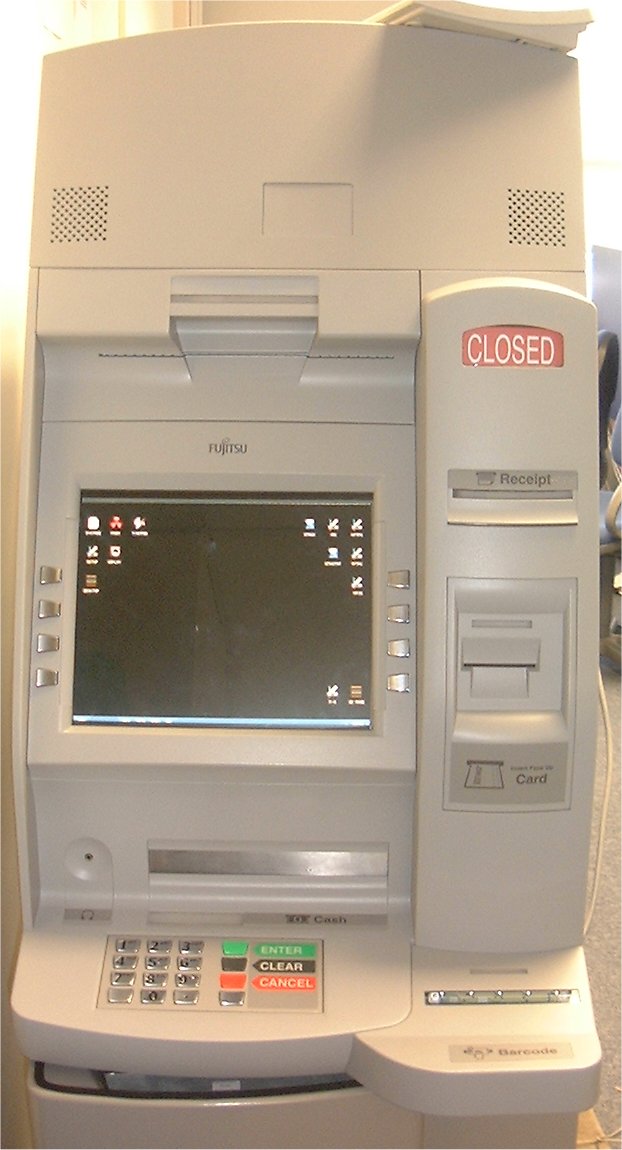
- used at the factory for SCADA-system;
- they performed numerical simulations of spectra for radiophysics problems (Mössbauer spectroscopy) and even defended a thesis - vak2.ed.gov.ru/idcUploadAutoref/renderFile/80179 (the CMspectra program was first written for KolibriOS, then ported to other operating systems — co-author Andrei Ignatyev, aka andrew_programmer );
- used on the server for a map (GIS) server ( more );
- on railway transport to automatically monitor the condition of the
rails( contact cable - editor's note ) based on the analysis of video information from a passing train (described in more detail in the comments below , the original is on our forum ).
(In the photo below - use at the factory for SCADA-system)

The question of embedding KolibriOS in the BIOS has been discussed for quite a long time, which will give certain opportunities to both programmers and users. ( Although even there is already one working example - editor's note. )
Thus, with hands and knowledge, KolibriOS can be adapted for any task.
At last - atmospheric pictures of fans: mine and South American.


Source: https://habr.com/ru/post/197360/
All Articles